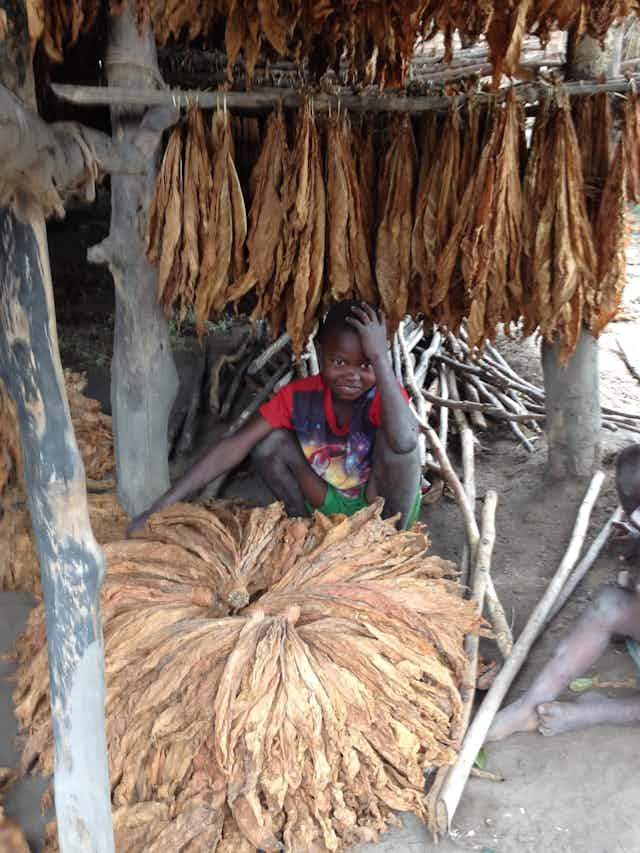“We have more than 20,000 … small-scale farmers growing tobacco … the industry is critical in reducing poverty levels.”
Or so says an official with the Zambian Development Agency who we interviewed for our study on the political economy of trade, tobacco control and tobacco farming.
He was not alone in this opinion, a common refrain we heard in all three of our study countries (Kenya, Zambia and Malawi). It is one that dominates the trade, development and finance ministries of many low-income, tobacco-growing countries.
With tobacco use down in most high-income countries, Africa is one of the new battle sites of Big Tobacco’s efforts to grow its consumer base, partly by fighting every government attempt to comply with the WHO’s Framework Convention on Tobacco Control (FCTC).
While still making spurious claims that such control measures violate trade agreements, one of the tobacco industry’s other key lobbying arguments is that tobacco growing is essential to the livelihoods of millions of small-scale rural farmers.
We set out to answer that question in our three sub-Saharan African countries, chosen for their varying reliance on tobacco as an agricultural crop and source of export revenues (Kenya the least, Malawi the most, Zambia in the middle).
Our detailed survey of more than 1,800 small-scale tobacco farmers focused on the overall well-being of their households, but one issue particularly intrigued us: Did growing tobacco really provide them the livelihood Big Tobacco and their governments claimed?
Paid in cash
Our study found that one of the reasons farmers grow tobacco is that they are paid in cash by tobacco leaf companies at the end of the season. Not all crops offer this sort of a guarantee.
“Contract” farmers are given an additional incentive. They work under contract to leaf-buying companies that supply them with everything they need at the start of the season — seeds, fertilizer, pesticides and so on — and guarantee a purchase (but not the actual price) at the end of the season.
Independent farmers, on the other hand, must buy their supplies using borrowed or saved money, and take their chances that there’s a buyer at season’s end.
There are only a few leaf-buying companies that control the purchasing market. It’s no surprise, then, that both types of farmers complained about the lower-than-reasonable price they are eventually paid for their crop, while contract farmers have the inflated costs of their pre-season supplies deducted from their take-home cash.
It’s one thing to ask tobacco farmers how much they earn in a year (what they sell their crop for minus what they pay for their seed, pesticides, fertilizers, etc.), and quite another to estimate the unpaid family labour that goes into tobacco growing.
Family members unpaid
Tobacco is one of the most labour-intensive crops grown in sub-Saharan Africa.
Any reasonable estimate of how dependent farmers are on tobacco for their family livelihoods should account for the family’s unpaid efforts, which we did by carefully calculating the total hours of (adult) family labour spent growing tobacco.
We monetized this time using the lowest wage these family members might otherwise have earned by, for example, working to help other rural farmers grow or harvest their crops. We called the first estimate (crop sold, pre-season supplies deducted) farmers’ “perceived profit per acre” and the second, deducting the value of the unpaid family labour (converted from local currency to U.S. dollars for ease of comparison), their “profit per acre adjusted for household labour.”
Across our three countries the differences were dramatic. See below:

The differences between perceived and adjusted profits were striking, and especially for contract farmers.
In Kenya, contract farmers lost money once their family labour was calculated.
Zambian farmers fared even worse, with both groups losing substantially when adding in all the unpaid hours of their family members. Contract farmers were actually reporting losses even before estimating their family’s free labour.
Malawian farmers did a little better, with contract farmers still posting a net gain even when accounting for their family workers.

In later focus groups, these farmers explained that there was a lot of pressure on them to work only under contracts, with the slightly better returns for contract farmers being used as incentives.
Even so, their profits were far below the average rural income in the country, and were worse than those for other cash crops (such as soya and paprika) for which there was comparative data.
Who’s really profiting?
It can be argued that monetizing unpaid family labour in a context of high unemployment and endogenous and extreme poverty is chimerical.
But then so, too, are the huge profits and wealth that big global tobacco companies derive from the unpaid, or simply just ill-paid, efforts of tobacco farmers.
In 2011, the year we started our study, British American Tobacco (BAT) and Imperial Tobacco posted profit margins of 34 and 39 per cent respectively. In 2015, the salary and bonuses for the BAT CEO topped US$10 million; for the Imperial CEO it still came in at US$5 million.
Just whose livelihood is tobacco farming supporting? Feel free to draw your own conclusion.

